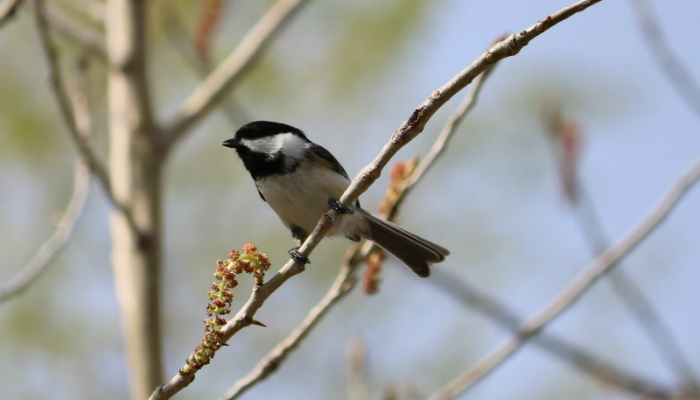Who Doesn’t Love the Charming Chickadee?

Who doesn’t have a fondness for the acrobatic, omnipresent black-capped chickadee? They’ve got it all in a tiny, boisterous package: good looks, an outgoing demeanor, and a fondness for sunflower and other seeds commonly found at backyard feeders. As an added bonus, they are year-round residents in Iowa so they help brighten our short winter days with their cheerful presence.
With their black and white blocked heads and distinctive buzzy chickadee-dee-dee call, chickadees are easy for even novice birders to pick out of a crowd. This call alerts both chickadees and other species to danger, and the more dee-dee-dees you hear, the greater the perceived threat. Males will often engage in a territorial call-and-response, with each two-tone, whistled fee-bee emanating in succession from a different shrub some distance away.
A chickadee’s diet varies throughout the year, with insects being favored in the summer when they are readily available. During the winter they may switch to seeds and berries, and they also appreciate some nice calorie-dense suet to help them through sub-zero winter nights. Chickadees are relatively fearless and can sometimes be coaxed to take seed from a human hand (though I have never had the honor).
Like their close relative the tufted titmouse, black-capped chickadees are cavity nesters and may make a home a a suitable nest box or an old woodpecker hollow, although they can also (surprisingly, given their rather diminutive bills) excavate their own nests. Females will lay 6-8 eggs and both males and females will help raise the young.
I can’t get enough of watching energetic little chickadees picking individual sunflower seeds from a feeder, carrying them to a nearby branch and whacking it repeatedly with their pointed black bills to get at the tasty nutmeat inside. They will also cache seeds in bark or among leaves to find up to several weeks later. There may be more going on in those tiny heads than we can imagine!
Originally published on Sycamore Greenway Friends
Tags: bird habitat, bird watching, chickadee, Melissa Serenda

